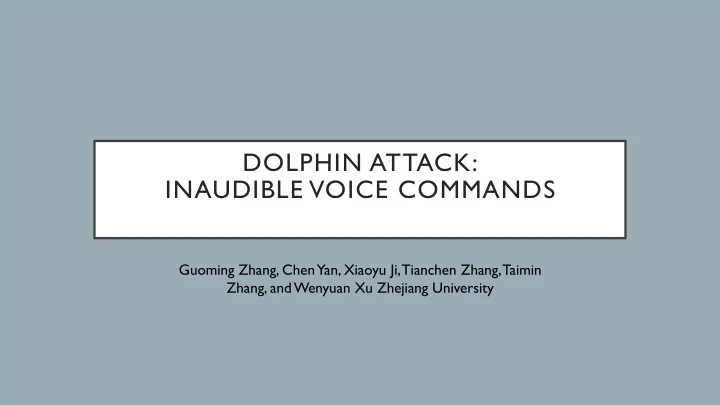

DOLPHIN ATTACK: INAUDIBLE VOICE COMMANDS Guoming Zhang, Chen Yan, Xiaoyu Ji, Tianchen Zhang, Taimin Zhang, and Wenyuan Xu Zhejiang University
BACKGROUND- DOLPHIN ATTACK An approach to inject inaudible voice commands at VCS by exploiting the ultrasound channel (i.e., f > 20 kHz) and the vulnerability of the underlying audio hardware 2
BACKGROUND SPEECH RECOGNITION • Allows machines or programs to identify spoken words and convert them into machine-readable formats • It has become an increasingly popular human-computer interaction mechanism because of its accessibility, efficiency, and recent advances in recognition accuracy 3
BACKGROUND - VCS • Voice Controllable System • Speech recognition combined with a system Apple iPhone – Siri Amazon Echo – Alexa 4
VOICE CONTROLLABLE SYSTEM 5
ATTACKS ON VCS • Visiting a malicious site • Drive-by-download attack • Exploit device with 0-day vulnerabilities • Spying • Initiate video/phone calls to gain visual/sound of device surroundings 6
ATTACKS ON VCS • Injecting fake information • Inject command to send fake texts/emails • Publish fake posts • Add fake events in calendar • Denial of service • Airplane mode • Concealing attacks • Dimming screen and lowering volume 7
BACKGROUND - MICROPHONE • Voice capture system that converts airborne acoustic waves to electrical signals • Two main types • Electret Condenser Microphone (ECMs) • Micro Electro Mechanical System (MEMS) 8
BACKGROUND SOUND WAVES • Human audible • 20 Hz < f <20 kHz • Ultrasonic • f > 20 kHz 9
THREAT MODEL • No target device access • No owner interaction • In vicinity, but not in use and draw no attention • Inaudible voice commands will be used • Ultrasounds • Attacking equipment • Speaker to transmit ultrasound • Speaker is in the vicinity of target device 10
FEASIBILITY ANALYSIS • The fundamental idea of DolphinAttack • To modulate the low-frequency voice signal (i.e., baseband) on an ultrasonic carrier before transmitting it over the air • To demodulate the modulated voice signals with the voice capture hardware (VCH) at the receiver • No control over VCH so modulated signals must be crafted so that it can be demodulated to the baseband signal using the VCH 11
FEASIBILITY ANALYSIS 12
FEASIBILITY ANALYSIS EXPERIMENTAL SETUP 13
ATTACK DESIGN • Case Study – Siri • Siri Activation • “Hey Siri” – in the tone of the user it is trained for • Generate Activation • Stolen phone (no owner) • Attacker can obtain a few recordings of the owner 14
ATTACK DESIGN • TTS-based Brute Force • Downloaded two voice commands from websites of these TTS systems • ”Hey Siri” from Google TTS was used to train Siri 15 35 of 89 types of activation commands activate Siri – 39%
ATTACK DESIGN • 44 phonemes in English • 6 are used in “Hey Siri” • “he”, “cake”, “city”, “carry” • “he is a boy”, “eat a cake”, “in the city”, “read after me” • Both able to activate Siri successfully 16
ATTACK DESIGN • Voice commands are now generated • Voice commands must be modulated onto ultrasonic carriers • Lowest frequency of the modulated signal should be larger than 20 kHz to ensure inaudibility 17
ATTACK DESIGN • Voice Commands Transmitter • A powerful transmitter with signal generator • The portable transmitter with a smartphone 18
ATTACK EXPERIMENT • https://www.youtube.com/watch?v=21HjF4A3WE4 19 List of system and voice commands set to be tested
20
• Experiments of researchers show that the modulation depth is hardware dependent • The modulation depth at the prime fc is when recognition attacks are successful and 100% accurate • The minimum depth for successful recognition attacks on each device is shown on table • Modulation depth m is defined as m = M /A where A is the carrier amplitude, and M is the modulation amplitude • If m = 0.5, the carrier amplitude varies by 50% above (and below) its unmodulated level 21
IMPACT OF LANGUAGE 22 activating SR systems -- initiating to spy on the user -- denial of service
IMPACT OF BACKGROUND NOISE 23
IMPACT OF ATTACK DISTANCE 24
DEFENSES • Hardware based • Microphone Enhancement • “a microphone shall be enhanced and designed to suppress any acoustic signals whose frequencies are in the ultrasound range. “ • Inaudible Voice Command Cancellation • add a module prior to LPF to detect the modulated voice commands and cancel baseband 25
DEFENSES • Software based • Use Supported Vector Machine to detect DolphinAttack • A supervised learning model using an algorithm to analyze data for classification 26
REALISTIC???? 27
CONCLUSION • Inaudible attacks to SR systems • Dolphin Attack leverages amplitude modulation • Hardware and software based defenses 28
Recommend
More recommend